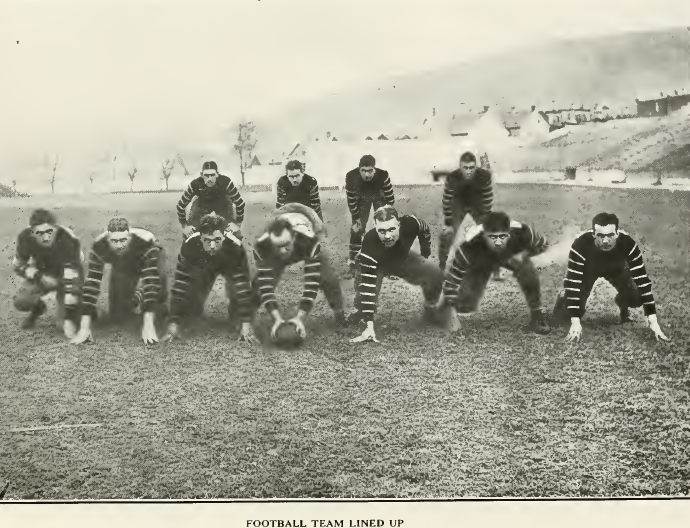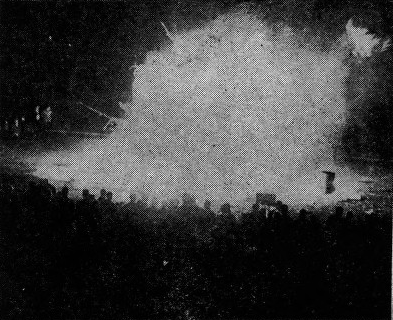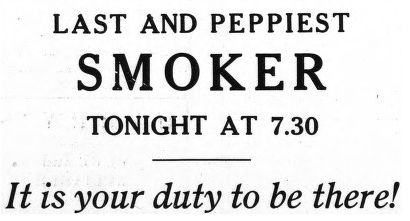Archive For The “A Rivalry: Stories From The Most-Played College Football Series” Category

It didn’t initially seem conceivable that war in Europe would affect the daily lives of American boys and men playing college football in Pennsylvania.
Before World War I broke out, or the Great War as it was then called, President Woodrow Wilson pursued a strict policy of neutrality in regards to the trench battles in Belgium and France, echoing popular opinion.
But when World War became inevitable, it naturally affected the campuses of Lafayette and Lehigh in the seasons of 1917 and 1918.
Through the seriousness of war, the Rivalry continued where other college football seasons were halted, complete with much of the same pageantry.
In tough times, the Rivalry provided a much-needed escape though the seriousness of the times.
Read more »

For a very long period during the Rivalry, parades and bonfires have played a large part of the festivities, though their timing and purpose have changed over time.
And just like “smokers”, parades bonfires started out as athletic celebrations separate from the Rivalry, but ultimately became intertwined with the traditions of the game.
The tradition of the parade and bonfire dates from the times when cars were still rare, and most of the transportation into South Bethlehem came by the Lehigh Valley Railroad, whose station was only a few blocks from campus.
Bonfires celebrating athletic victories were not unknown in the late 1890s at both Lehigh and Lafayette, as well as parades for successful athletic teams. They may have been inspired by Harvard, Yale and Princeton, who were starting to celebrate their biggest victories over each others with large bonfires.
Read more »

In 1927, the Rivalry was in trouble.
“Thousands of vacant seats at Saturday’s game, mostly on the south side of the field, were a silent protest to Lehigh’s poor teams,” the Easton Express wrote after another lopsided Engineer loss to the Leopards. “The dear public was asked to part with $4 a ticket to see Saturday’s game. Of course, the public doesn’t have to go. They can stay at home. That is what many did on Saturday. But there are thousands of Alumni of both institutions who deplore the situation and a crying for relief.“
The game in question was a 43-0 shellacking by Lafayette, capping off a dismal 1-7-1 season for Lehigh where the Brown and White were outscored 196-31 by their opponents.
For Lehigh, losing to Lafayette had become routine. It was their eighth straight loss to their rivals. The Brown and White had last scored a touchdown against Lafayette in 1921. Three entire classes had gone without scoring a touchdown against them, let alone come close to victory.
In the span of two years, though, Lehigh would break Lafayette’s spell – first by scoring their first touchdown against the Maroon and White in nearly a decade, and then by beating them in one of the closest games in Rivalry history.
Read more »

The first organized cheering during the Rivalry games appeared to come up organically from Lafayette’s and Lehigh’s students.
By the 1890s and the advent of professional coaches, though, faculty and coaches got more involved in cultivating spirit in the teams.
Lafayette’s legendary coach Parke H. Davis, contributing to Athletics at Lafayette College, makes no bones about his contributions, making the “creation of an intense football spirit” at Lafayette one of his priorities when he was hired.
“We instituted college mass-meetings,” he said. “We composed songs. At that time there were none. We invented new cheers. We bragged and blustered, orated and printed glowingly about our prospects. We worked the college and the town systematically up to a football frenzy.”
“Smokers” were athletic pep rallies which took place on the campus to celebrate a wide variety of events, as was the custom on college campuses at the time. During these extravaganzas, the students got souvenir pipes from the smoker as well as complimentary tobacco products.
Smokers took colleges by storm in the 1910s, but for Lehigh and Lafayette, the history of these types of meetings goes back further.
Read more »

Going into the 1912 season, the Rivalry was at a point when Lafayette was a dominant force over the Brown and White.
In an era where Princeton, Yale, and the Carlisle Indian School all competed for the top, Lafayette was right there alongside the top teams in the nation.
And soon, Lehigh would be in the conversation once again as well.
In 1911, Lehigh announced their seriousness to vault back into contention by signing four key transfers, including a future Brown and White hall-of-fame quarterback, QB Pat Pazzetti, from Wesleyan.
“The Pennsylvania college is pulling strongly for a record-breaking football team this year – hoping to put one on their old rival, Lafayette – and is doing all in its power to get the athletes in the institution,” The Lafayette reported.
Read more »

It was common knowledge in 1893 that Lehigh was a rich institution.
“[Our] forced economy in itself is a great hindrance to our success in athletic competitions,” a 1890s letter sent out by Lafayette’s alumni committee said. “Our nearest antagonists – Lehigh, Princeton, Pennsylvania – are now so wealthy, that we, with our comparatively untrained teams, are at great disadvantage. Our alumni all desire our success but few realize how much this success depends on them.”
Thanks in no small part to Asa Packer’s bequest to Lehigh of a huge sum of money and stock after his death in 1879, the University was the richest institution of higher learning at that time, surpassing, according to the New York Times, even Harvard and Yale.
The vastness of Lehigh’s endowment was actually controversial.
“In one view, the gift is the noblest one of the kind ever made,” the New York Times said of the bequest, “for it establishes the only institution – so far as we know – which gives absolutely free tuition to all comers, rich or poor. It is merely in an economic sense that the opinion is expressed that any addition to the more than 300 colleges now dwarfing and starving one another in this country is wicked waste of resources.”
For more than a decade Asa’s success in building the railway and navigating the business dealings of the railroad barons kept his family, and Lehigh University, rich, even a decade after his death.
But in 1893 that would begin to change.
Read more »

Lafayette dominated the early Rivalry, but in the late 1880s the tides turned dramatically, thanks to a play devised by the founder of Lehigh’s football program.
And, perhaps unsurprisingly, the origins of the play have also been disputed with a distinct Lehigh/Lafayette flavor.
The “V Trick”, or “Lehigh V”, as it’s known in South Bethlehem, was a revolutionary play in college football at the time.
It involved, on a kick resulting in a change of possession, to have the eleven men form a “V” with interlocked arms to direct the mass of the entire team against a hapless weak link on the opposition’s line, with the halfback running behind the rush line.
This was especially effective after a kick, since the ten men would be able to run forward and get a head of steam going, applying their mass momentum to make larger gains. To some, it was the basis of all the mass momentum plays that followed, such as the infamous “Flying Wedge” implemented by Harvard.
Though it would ultimately be banned, plays like the “V Trick” were an important historic milestone in the evolution of college football.
And the origins of the play come down to who you believe: Richard Harding Davis, the former Lehigh football player, or Parke H. Davis, the former Princeton and Lafayette football coach.
Read more »

The same year Lehigh and Lafayette started their football Rivalry, the cornerstone for the Statue of Liberty was laid down on Beldoe’s Island on August 5th, 1884.
In attendance at that event was the president at that time, Republican Chester A. Arthur, and Democrat Grover Cleveland, who would win the presidential election later in the year.
In 1884, Mark Twain lived in a house just outside Hartford, Connecticut, a Victorian Gothic mansion where he and his family settled after he had penned The Innocents Abroad. That year, in the upstairs billiards room, he wrote Huckleberry Finn.
More local to the Rivalry, in that same year the city of Easton would get electric power for the first time in its history. “Electric lights now burn brightly in Easton’s streets,” the Lafayette student newspaper noted, “and in many of her business houses and places of amusement.” (South Bethlehem wouldn’t get electric streetlights until 1887.)
It also would be year of the first-ever meetings between Lehigh and Lafayette on the gridiron, only a couple of years after the early collegiate athletic powers of Harvard, Yale, Princeton, and others had established standardized rules for “rugby football”, as it was still called at the time.
Read more »
